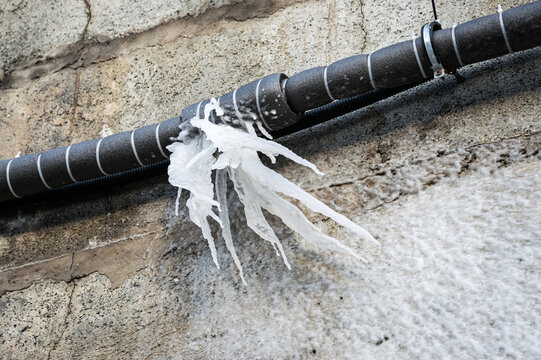Prevent Frozen Pipes in Cold Weather: Professional Tips
Get EstimateThe article on the next paragraphs relating to How to Prevent Your Pipes From Freezing is absolutely informative. You should give it a look.

Winter can damage your plumbing, specifically by freezing pipes. Below's how to stop it from taking place and what to do if it does.
Intro
As temperatures decrease, the threat of icy pipes rises, potentially causing expensive repairs and water damages. Understanding just how to stop icy pipes is vital for home owners in cool climates.
Avoidance Tips
Protecting vulnerable pipelines
Cover pipes in insulation sleeves or utilize heat tape to shield them from freezing temperatures. Concentrate on pipes in unheated or exterior areas of the home.
Home heating methods
Maintain indoor areas adequately warmed, particularly locations with plumbing. Open closet doors to allow warm air to flow around pipes under sinks.
Exactly how to determine frozen pipelines
Try to find decreased water circulation from faucets, unusual smells or sounds from pipes, and noticeable frost on subjected pipes.
Long-Term Solutions
Structural modifications
Consider rerouting pipelines far from exterior walls or unheated locations. Add added insulation to attic rooms, basements, and crawl spaces.
Upgrading insulation
Buy premium insulation for pipelines, attic rooms, and wall surfaces. Proper insulation assists keep consistent temperature levels and minimizes the risk of icy pipes.
Securing Outdoor Plumbing
Garden tubes and outside taps
Detach and drain pipes yard hose pipes prior to wintertime. Install frost-proof spigots or cover outside taps with shielded caps.
Understanding Icy Pipes
What causes pipes to freeze?
Pipes ice up when subjected to temperatures listed below 32 ° F (0 ° C) for extended periods. As water inside the pipelines freezes, it broadens, putting pressure on the pipeline wall surfaces and potentially triggering them to break.
Risks and problems
Icy pipes can result in supply of water disturbances, residential property damages, and pricey repair services. Burst pipelines can flooding homes and cause considerable structural damage.
Indications of Frozen Piping
Recognizing icy pipelines early can avoid them from bursting.
What to Do If Your Pipes Freeze
Immediate activities to take
If you presume icy pipelines, keep taps available to relieve stress as the ice thaws. Use a hairdryer or towels taken in hot water to thaw pipes gradually.
Conclusion
Preventing frozen pipes needs aggressive measures and fast feedbacks. By understanding the causes, indicators, and safety nets, house owners can protect their pipes during winter.
6 Proven Ways to Prevent Frozen Pipes and Protect Your Home
Disconnect and Drain Garden Hoses
Before winter arrives, start by disconnecting your garden hoses and draining any remaining water. Close the shut-off valves that supply outdoor hose bibs and leave the outdoor faucet open to allow any residual water to drain. For extra protection, consider using faucet covers throughout the colder months. It’s also important to drain water from any sprinkler supply lines following the manufacturer’s directions.
Insulate Exposed Pipes
Insulating your pipes is an effective way to prevent freezing. Pipe insulation is readily available at home improvement stores and is relatively inexpensive. Pay close attention to pipes in unheated areas such as the attic, basement, crawl spaces, or garage. Apply foam insulation generously to create a buffer against the cold. You can also wrap your pipes in heat tape or thermostat-controlled heat cables for added warmth.
Seal Air Leaks
Inspect your home for any cracks or openings that could let in cold air. Seal any holes around the piping in interior or exterior walls, as well as the sill plates where your home rests on its foundation. Additionally, make sure to keep your garage door closed unless you’re entering or exiting. Leaving it open creates a significant air leak that can lead to frozen pipes.
Allow Warm Air Circulation
During cold snaps, it’s essential to allow warm air to circulate evenly throughout your home. Leave interior doors ajar to promote better airflow. Open kitchen and bathroom cabinets to help distribute heat consistently around the rooms. If you have small children or pets, be sure to remove any household chemicals or potentially harmful cleaners from open cabinets for safety.
Let Faucets Drip
A small trickle of water can make a big difference in preventing ice formation inside your pipes. When temperatures drop significantly, start a drip of water from all faucets served by exposed pipes. This continuous flow helps prevent the water from freezing. Additionally, running a few faucets slightly can relieve pressure inside the pipes, reducing the chances of a rupture if the water inside does freeze.
https://choateshvac.com/6-proven-ways-to-prevent-frozen-pipes-and-protect-your-home/

Do you like more info about Preventing and dealing with frozen pipes? Give a remark below. We will be delighted to hear your feelings about this write-up. In hopes that you visit us again before long. You should take a moment to promote this write-up if you enjoyed reading it. I enjoy reading our article about 6 Ways to Prevent Frozen Pipes.
Book Now!